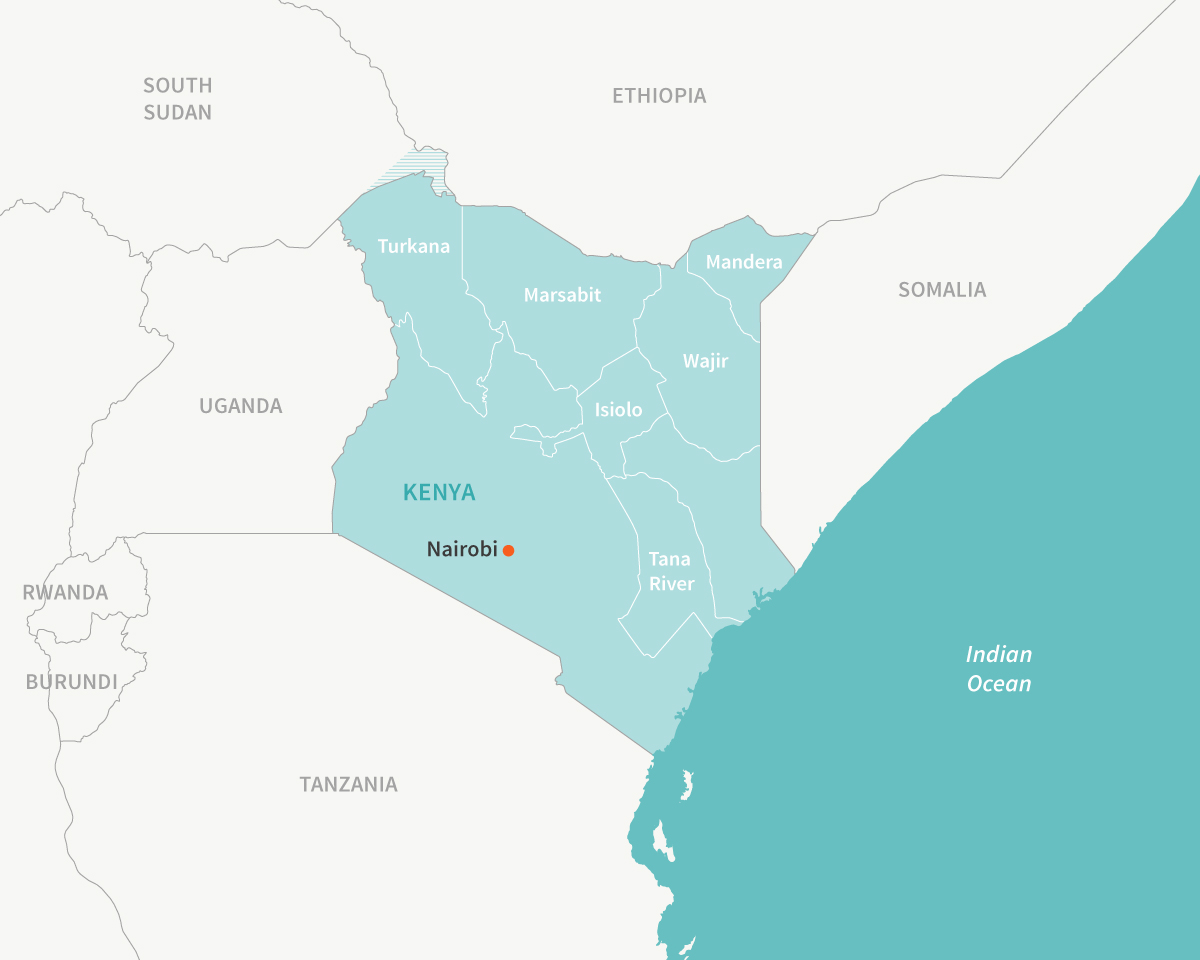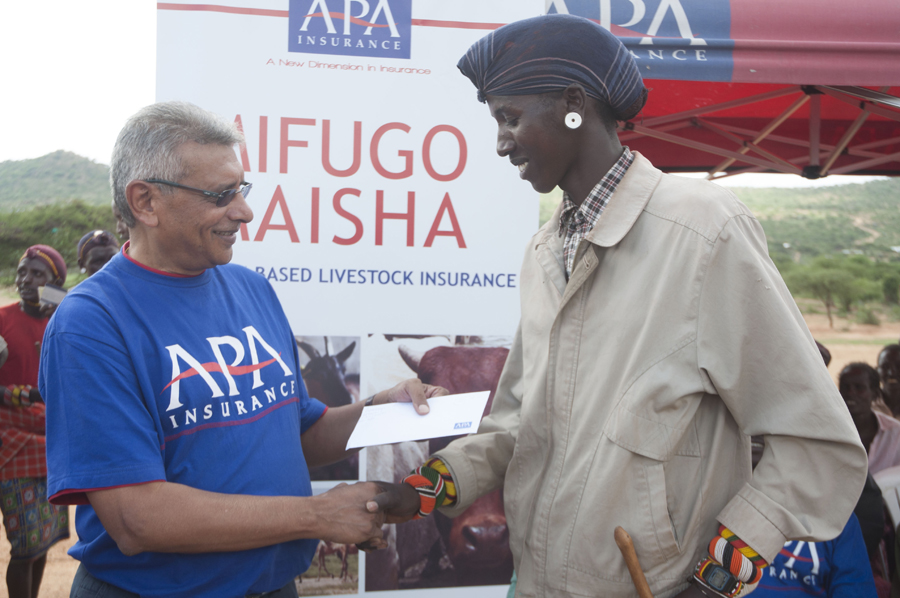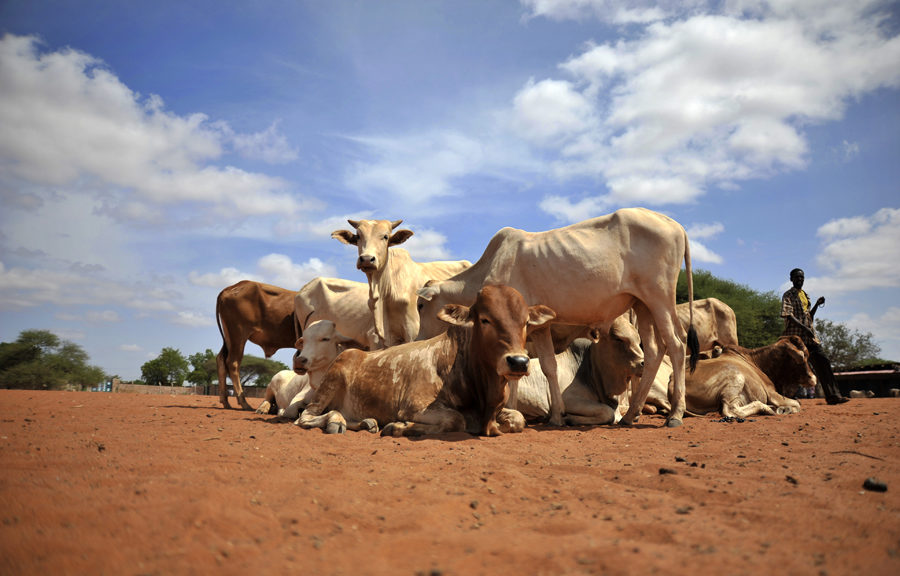When the rains failed to come last year in central Isiolo County, Kenya, Mohamed Dahir figured he might lose 40% of his herd of 400 sheep and goats. Like several million other pastoralists in northern Kenya and across the border in Somalia and Ethiopia, Dahir and his herd live migrating between pastures.
Dahir did indeed lose some animals, but he received a payout from an emerging kind of livestock insurance: based on predictions of vegetation growth in the area and how many animals that might harm, his index-based livestock insurance policy gave him 50,000 Kenyan shillings (about £370) in cash before the drought and its consequences really settled in. He was able to buy enough hay from distant counties to save 95% of his herd.
Index-based livestock insurance gets its name from the ecological indices used to calculate it, such as rainfall and vegetation growth. It now covers over 15,000 Kenyans in both commercial and government-issued varieties. The Kenyan programmes, established by the International Livestock Research Institute (ILRI), a CGIAR research centre in Nairobi, have paid out several times including a record US$2.2 million (£1.7 million) in early 2017.
But it took several tries and careful tuning to different communities across Kenya to create the livestock insurance policy. The insurance will probably require constant updating in the face of climate change and other shifts affecting its target population and the ecosystem in which they live.

Shamsa Kosar, a beneficiary of Takaful insurance in Wajir. Courtesy of ILRI.
Insured at home on the range
Several years ago, Dahir learned about livestock insurance at a sales meeting, and had seen advertisements for it in local newspapers. Pastoralists at the time, Dahir recalls, had “heard about car insurance, health insurance, but they’ve never heard about livestock insurance”.
The architect of Dahir’s insurance is ILRI economist Andrew Mude, who grew up in northern Marsabit County, which borders Isiolo and was the first test site for index-based livestock insurance. A decade ago, Mude and other ILRI researchers began looking for better ways to manage the risks of dryland pastoralism. Pastoralists in the region have managed climate risks for millennia. They tread lightly on the land, which is too dry to grow crops, accompanied by goats, sheep, cattle, or camels, in search of forage. In a good year, rain falls in two seasons: one short, one long. Water holes appear, grasses spring up, and herders follow the grasses. Such migration, Mude says, “is their main risk management”.
Every few years, however, the rains fail to fall. Then the government officials appear, aid distribution centres spring up, and herders follow the water tankers. But such aid can arrive late, or not at all, and community members are suspicious of official corruption and incompetence.
Instead, vulnerable pastoralists often sell their livestock. That short-term solution creates a classic poverty trap, just like when a farmer sells or eats her seeds instead of planting them.1

ILRI tested index insurance in six semi-arid and arid Kenyan counties. The hashed area denotes the contested Ilemi Triangle. Illustration: E. Wikander/Azote.
ILRI researchers began reading about index insurance in the economics literature, including a World Bank report on a pilot study in Mongolia. Mongolia provided a successful example: herders bring their animals together for an annual livestock round-up, a holdover from Soviet-era management practices. That unusual gathering simplifies counting the animals. Checking claims on widely scattered livestock is expensive; insurance companies were not bothering to offer insurance like they do for cars or other easier-to-calculate types of insurance.
In place of a round-up, the researchers had access to reliable data on historic livestock mortality from economic, anthropological, and public health studies of the region. They could relate those data to public satellite data on vegetation in Kenya’s arid north. Index insurance began to look like “a more proactive, cost-efficient way of responding than the more-reactive cash aid and food aid”, Mude says.
A microcosm of the micro-insurance boom
Index-based insurance, which can cover crops as well as livestock, is booming around the world: the World Bank has programmes in India, Mongolia, South America, and elsewhere in Africa. Satellite imagery is available even places insurance adjusters find difficult to visit, and mobile phones enable local sales agents to handle once-complicated transactions.
“You can tell this nice story about this technically elegant product”, says University of Oregon geographer Leigh Johnson, who conducts participant-observer research on ILRI’s index insurance. That technology angle makes index insurance seem easily replicable in many settings. “But actually engaging on the ground with people about what they understand or how they feel they’ve benefited from it … it’s really involved”, Johnson says.
You also have to sell it, which Mude and his colleagues soon found out was harder than it seemed. The ILRI team spent several years designing their index-insurance programme, recruiting local insurance and banking partners, and raising funds for a trial, which began in January 2010.

The team’s experiments with satellite data showed they could use it to determine the probability of good and bad foraging for pastoralists’ animals. Courtesy of ILRI.
Their elegant ideas soon foundered on miscommunication. Not enough clients knew about the product: ILRI left getting the message out to the banks and its commercial partners, UAP Insurance and Equity Bank. Sales agents sold index insurance on commission, but some clients misunderstood what they were buying. “There comes a challenge if the same population that you are trying to target has low literacy levels”, says Duncan Khalai, a more recent ILRI hire working on market and capacity development for the index-insurance programme.
Sales agents inflated their client’s expectations to the point that some policy buyers believed they would be reimbursed, no matter what. Some buyers may have been further confused by the fact that Equity was the distribution partner for the insurance as well as for the Hunger Safety Net Programme, an unrelated unconditional cash transfer programme operated by the UK development agency DFID, Johnson and colleagues write in a manuscript now under revision.
Sales during the opening 2010 season exceeded predictions. The next year, a drought led to the system’s first payouts in October 2011. ILRI found that households that received payouts were 36% less likely to want to sell livestock and 25% less likely to reduce meals during the drought.
But trouble was brewing. The commercial partners told ILRI they wanted to expand as fast as possible to Kenya’s more populous, richer southern counties, which promised commercial sustainability. But ILRI’s mission, and its funders’ priority, was to serve needier communities. Equity and UAP also failed to recruit enough agents one season. ILRI cancelled a subsequent sales window and its sales partners backed out. Equity spokesperson Elizabeth Muriu says that “the program would have needed to be expanded to more areas to ensure it was sustainable”.
So for two dry seasons, nobody returned to sell index insurance in Marsabit County.
“We came in naively believing that this could be commercially sustainable” within a few years, Mude says. Instead, during 2011 and 2012 sales dropped to an average of 454 per growing season, down from 1,975 policies per season in 2010. In 2012 DFID published a pessimistic report on index-based insurance. Without enough buyers, the ILRI team could not evaluate the insurance and in the longer term it would fail commercially.
Mude and his colleagues had to make a tough decision. They decided to get into the insurance marketing business.
Revising for better results
The ILRI team revamped educational materials to work on mobile phones, even offline. The ILRI app updates based on a user’s location and the vegetation levels they enter. The app then shows what payout the user can expect. The team tried games, videos, and radio broadcasts in different regions, to assess the impact of each marketing effort on purchasing. And they re-thought how they offered their insurance. They partnered with two insurance companies, one of which began offering a sharia-compliant policy in 2013 at the request of Muslim pastoralists.
Unexpected lessons followed. For example, bigger herd sizes in some areas made the programme more cost-effective, which allowed it to grow within its priority region. Selling policies through shopkeepers instead of roaming part-time agents ensured continuity and stability for clients. “There’s already an established level of trust between the shopkeepers and the community”, Khalai says.

An agent for Takaful Insurance of Africa stands outside his shop. ILRI began working with other insurance companies after hitting stumbling blocks with its first partner. Courtesy of ILRI.
All along, ILRI collected data on the impact of the index insurance on clients’ social welfare. They reported that index insurance was helping clients keep their animals in bad times – and escape the historic poverty trap – while reducing the need for emergency aid. Above a certain size, the programme was cheaper to administer than cash handouts, Mude and his colleagues estimated.2Throughout 2014, the team worked on designing a version of index insurance that the Kenyan government could offer to needy households in six counties.
ILRI made one more significant change to its index insurance. Talks with aggrieved community members, left in the lurch by the previous insurance company partner, helped ILRI decide to “change to asset protection instead of asset replacement”, says Khalai. In other words, the team realised they needed to pay their clients sooner, before animals died, rather than afterward. This helped satisfy a cultural need, Mude says: the pastoralists “would say ‘this all sounds good, but do you need to wait for our livestock to die?’”.
Partners in payouts
Perhaps the most momentous change was accepting that, as in richer countries, agricultural insurance may need government support. The US government has backed agricultural insurance for farmers since the 1930s. By late 2015, the Kenyan government was ready to bankroll “backstop” insurance for households with herds of five animals or fewer. These families find it hardest to migrate and are most vulnerable to local drought conditions. The government programme, called the Kenyan Livestock Insurance Program, made record payouts earlier this year in 6 counties and is scheduled to expand to more than a dozen counties.

One of ILRI’s partner insurance companies, APA Insurance, holds public events as part of an effort to raise the profile of the index-insurance program. Photo courtesy of ILRI.
Growth is difficult: ILRI has done painstaking work to tune its vegetation-mortality model for small regions within counties. It will have to repeat that anywhere its partners expand their coverage. But it is important, because a larger risk pool can reach far enough across the region to handle widespread droughts.
Thanks to this year’s high-profile drought and payouts, including the one in which Dahir received preventative payments for his animals, Khalai expects a shift: “The level of confidence in the product should really, really rise, both on the side of the donors, the government, and on the side of the beneficiaries”, he says.
Still, agricultural insurance carries a risk of unintended consequences for the environment, warns Birgit Müller, an environment modeller at the Helmholtz Centre for Environmental Research, Germany. It has encouraged firms in rich countries to plant monocultures, or single-species crops, which are less resilient than mixed-crop cultivation, and to encroach on wetlands that would not otherwise be cost effective to cultivate.
Farmers end up poaching the wetlands’ ecosystem services by replacing natural water-purifying, biodiversity-promoting landscapes with cultivated fields and dump pesticides and nutrients downstream. But in those places, reforms have already begun. “I would like [it if] those policymakers which give a lot of money to foster the development in Africa don’t make the same mistakes as before”, Müller says.
In a step that might head off such mistakes, Mude and his colleagues have explored a method for creating maps of where the insurance would be viable, based on livestock density, aridity, and other readily calculated measures.3Herders are also conscious of the impact of their livestock on the changing carrying capacity of the land. Dahir says that in his region some herders are using their insurance payouts to replace cattle with camels, which have less impact on the environment and may be better suited to what he sees as an increasing frequency of droughts.

Camels near a borehole near Wajir. Courtesy of ILRI.
Other researchers are asking whether agricultural insurance, including index insurance, promotes a breakdown in traditional social risk-sharing. Mude worries that such systems are already eroding, for a mixture of reasons including emigration and changes in livelihoods.
The entire effort is part of a global insurance industry effort to design so-called micro-insurance policies for the developing-world market. The Group of Seven, a club of rich countries, began promoting in 2015 an initiative called “InsuResilience”: providing climate risk insurance to 400 million more people by 2020. Some researchers argue that the next step is to combine index insurance with bank loans or similar financial products, as India has done. That could help index insurance share the costs of marketing and management.4
But Müller says she is wary of insurance as a one-size-fits-all strategy. Instead, she suggests people might consider combining insurance aimed at the most extreme drought events, perhaps the kind climate change might provoke, with traditional strategies for coping with normal ecosystem variation. “If you’re moving from a more diversified farming system with higher levels of biodiversity to a less diversified system, you may be removing some of the ‘natural insurance’ from the system”, warns Johnson, who partnered with Müller to write a review of climate insurance and some of its unexpected consequences.5
Meanwhile, in Kenya, the ILRI insurance may have already overcome the biggest first hurdle: regaining trust. When insurance agents first touted index insurance in his town, Dahir recalls, people wanted to know “the reliability, and how they are going to receive their payment. If the agents are not going to disappear. Because, you know, the trust, the first thing is to build the trust.”
